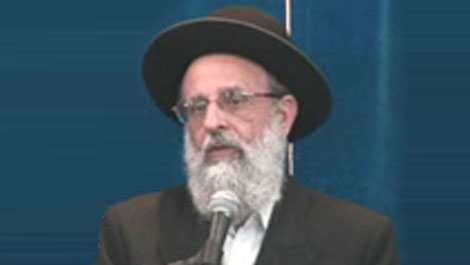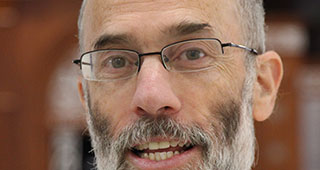Beit Midrash
- Family and Society
- Jerusalem and The Holy Temple
- The Holy Temple - Beit Hamikdash
The Torah study is dedicatedto the full recovery of
Lea Bat Rahma
2. The Source of the World
3. Gazing Upon the Temple Mount
The Sanctity of Jerusalem
Rabbi Moshe Maimonides, the Rambam, writes that Jerusalem and the Holy Temple were imbued with sanctity once and forever, and that this sanctity was not nullified by the Temple’s destruction - for the sanctity of Jerusalem and the Sanctuary are due to the Divine Presence, and the Divine Presence cannot be nullified. Rambam brings support for his position from the words of the sages: "Even though it is desolately destroyed, it continues to be holy (Hilkhot Beit HaBechirah, chpt. 6).
Rabbi Avraham ben David of Posquieres, the Raavad, disagrees. He is of the opinion that though the it was once imbued with sanctity, Jerusalem’s sanctity is no longer. He explains that Ezra the Scribe, in the time of the Second Temple, knew that the Temple and Jerusalem would eventually be resanctified with a new and lasting sanctity, honoring God eternally. "This was revealed to me," writes the Raavad, "as a secret of God for those who fear Him."
According to Chatam Sofer (Yoreh Deah 233-4) even Raavad, who holds that one who enters the Temple Mount is deserving of Divine punishment, agrees that the place of the Temple possesses extreme holiness even today, and that it is the gateway to heaven, and that even before the land was sanctified by Joshua, Adam and Noach had already offered up sacrifices there, and Abraham bound Isaac on that site, and it was there that Jacob had his dream of the ladder rising up to heaven and exclaimed, "This is surely none other than the House of God, and this is the gate to heaven." Chatam Sofer adds that in the days of the Geonim Jews would journey to Jerusalem during the three Pilgrimage Festivals.
The Tashbetz writes that there exists evidence and proof that sanctity continues to adhere to the place of the Temple and the entire city: People (in his day) continue to make the thrice-yearly Festival pilgrimages from Egypt and other countries. And, says Tashbetz, a hint to this effect can be found in the Midrash (Shir HaShirim Rabba, 8:10), which, in expounding upon the words "I am a wall" in the Song of Songs, informs us that "even though the Temple is in ruins, the People of Israel have not ceased making the pilgrimage thereto three times a year." What’s more, they say that some of the miracles which were present in the days of the Temple continue to occur there. Specifically, that you never find one saying to his friend, "its very congested here." For, though the synagogue in Jerusalem is only large enough for the resident population throughout the year, it becomes filled when Festival celebrants gather there during the Shavuot holiday. More than three hundred people enter therein, yet they manage to sit comfortably. This is because the sanctity of Jerusalem remains, and it is a sign of the imminence of the third and final redemption. (Vol. 3, Chpt. 201)
The Tashbetz, then, like Rambam, holds that Jerusalem continues to possess sanctity. Chatam Sofer goes further and says that Jerusalem and the Holy Temple possess a sanctity which is independent of all outside factors. A kind of sanctity which has existed from time immemorial and will continue to exist forever. This sanctity existed independently of the sanctity which King Solomon bestowed upon the Temple, and therefore did not dissipate with the destruction of the Temple. Accordingly, already the forefather Jacob concluded, "This is the gate to heaven."
Similarly, Rabbi Yaakov Emden points out that Jacobs saw that, "This is the gate to heaven" and that the prophets note, in the course of relating King Solomon’s prayer at the dedication of the Temple, that "they will pray to You from their lands," and, finally, concerning Daniel the Prophet, "The windows of his upper chamber were open in the direction of Jerusalem." Rabbi Emden adds that the nations of the world are also in agreement that prayers rise and are received only through the Temple in Jerusalem. The Rabbi concludes by telling us that when praying one should look to the city wherein God chose to have His Divine Presence reside - despite its ruin, it maintains its sanctity - and imagine that you are standing in the Sanctuary, before the Ark of the Covenant. He adds that it is not enough to direct ones prayer to Jerusalem, but that as soon as it becomes possible to immigrate to Israel one must do so. (Introduction to the Siddur of Rabbi Yaakov Emden, pg. 11)
The Source of the World
The author of Chesed LeAvraham writes that there is a window in the sky which matches the size of the Holy Temple, and that the Temple rests exactly under this window. Divine abundance flows down from above through this window upon the Holy Temple, and from there spreads out to the rest of the Land of Israel. On the ninth of Av this window was completely closed up and the Divine abundance was discontinued and the Temple was destroyed. Then, immediately after the Temple was destroyed, God opened the window a little bit and the Divine abundance flowed through the small opening that remained (Chesed LeAvrahm, pg. 46).
According to Chesed LeAvraham, then, the source of all abundance in the world always derives from the opening in the sky which is above the Temple. From there it flows down upon the site of the Temple and from there spreads out to the entire world. This idea is in keeping with the words of the sages who wrote: "The Foundation Stone (in the Holy of Holies) is named so because it is upon this very stone that the entire world was founded." And Ramban, in his introduction to the Torah, explains that the Foundation Stone is the place of the Sanctuary, and it is the source of the world, and from it the entire world evolved. Yet, the implication here is not merely an abstract or conceptual one (i.e., that the Temple is the most important place in the world and that it gives the world its reason for existing and without it the world has no reason to exist), rather, it is to be understood literally as well - that the world indeed evolved out of this very stone.
We find, then, that the place of the Holy Temple in Jerusalem is not only the source from which the entire creation came into being, upon which the entire world was formed, rather, that it always has been and will always be the source of all existence and the Divine bounty which flows down upon the world in order to sustain it. It is for this reason that we direct our prayers to this site. - the "gate to heaven."
In this vein, the Midrash teaches: R’ Shemuel bar Nachmani said, "Until the Temple was destroyed the Divine Presence resided in the Sanctuary...; When the Temple was destroyed, God’s throne retreated to the sky." R’ Elazar said, the Divine Presence remains fixed there (at the site of the Temple) regardless of whether or not the Temple is standing..." (Yalkut Shimoni, Melakhim).
Gazing Upon the Temple Mount
What can we do today in order to strengthen our ties with the Temple Mount, the site of the Temple? Undoubtedly, the first thing we can do is pray for the Temple’s speedy restoration. And our prayer must be for the perfect and complete redemption. In the words of the Midrash: R’ Simon bar Menasiah said, "Israel will not merit seeing a sign of the redemption until they repent and request three things: the Kingdom of Heaven... the Kingdom of the House of David... and the Holy Temple." According to the Midrash, then, all three of these things must be requested, for the honor of Heaven depends upon the honor of Israel - i.e., their redemption and the rebuilding of the Temple.
And just what can we do besides prayer. What act can we perform which will serve to express our desire to see the Temple rebuilt, the Divine Presence appear, and honor given to Heaven? We must do what we can: to visit and gaze upon the site of the Temple. The act of looking possesses great value. Chessed LeAvraham has the following to say concerning seeing the Land of Israel: "One should know how important it is to gaze upon the Land of Israel from afar, even though one does not enter therein. For we find that regarding the punishment meted out against the Children of Israel for believing the slanderous report of the spies, scripture uses the expression, "...if even one of these people see the land (i.e., not only was it decreed that they not enter the land, but even that they not see it.) Concerning Moses, too, it is written that he was allowed to see the land of Israel from afar. Many similar examples can be found which point to the importance of seeing and looking at things.
Chesed LeAvraham continues, explaining that what one sees with his eyes effects the power of imagination and makes a big impact on a person. When one looks at a holy object or site it has a positive effect upon him; when one beholds a negative sight, though, it has a harmful effect upon a person. Therefore, the Torah teaches, regarding negative matters, "Do not stray after your eyes," and regarding the good, "May your eyes behold your teacher." Since, then, we cannot enter the place of the Temple, we can at least gaze upon it. We can build towers from which to look at the Temple Mount; we can parade around the Temple Mount upon its walls. This will serve to express that the site of the Temple is our most holy of sites, and not as estranged Jews and others who believe - that the Western Wall is the holiest site. We must also demand that the Temple Mount be made off limits to strangers, so that they not desecrate it. And when we come in great numbers to and encompass the Temple Mount and pray towards it from all directions, the Almighty will hear our prayers, and may it be His will that the Holy Temple be rebuilt speedily in our day.

Will Life With the Temple Rebuilt Still Be...Fun?
Rabbi Refael Wassertheil | Adar I 24 5782

Levi'im and Kohanim- What's the Difference?!
Ein Aya, Shabbat 2, 246
Rabbi Ari Shvat | Kislev 16 5781
Indifference toward the Temple Mount
Rabbi Zalman Baruch Melamed | 10, Tevet 5762






















